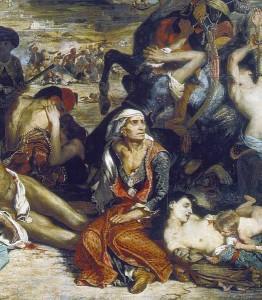Mesta History
To protect themselves and their precious product, the inhabitants of the mastic producing villages (collectively named Mastihohoria) had to turn their villages into impregnable castles; this is where Mesta owes its name and creation.
During the Byzantine era, the people of a number of small villages, unable to resist the continuous attacks by Arab pirates, decided, under Byzantine guidance and help, to gather to a new well-fortified village. Their decision was so mature and knowledgeable, in Greek “mesti,” that they named the new village Mesta.
From 1346 to 1566, under Genoese occupation, Mesta received its final major transformation. The Genoese, in particular the company “Maona,” that had the exclusive rights to exploit the products of the occupied territories, to protect mastic production and commerce against the ever-growing danger of pirate attacks, reorganized the defense infrastructure of the village, building three defense lines:
a. an outer wall having one opening for gate, fortified with elevated fighting towers at its corners and protected fighting posts along its sides;
b. a second defensive wall inside the first one, following the same pattern; and
c. a huge four-storied tower in the middle, 20 meters (60 feet) high, with no doors at all (access to it was only possible by climbing-ropes and rope-ladders), with semi-circular defense towers at its corners, big enough to offer protection to all the inhabitants of the village and to commodities like olive oil, wheat, and wine, all necessary to sustain a long siege. An underground tunnel gave access to the nearby Milita Well (the rope tracks are still visible around the well’s “mouth”); from there, another tunnel led beyond the Walls, offering a safe way out in case all defense measures failed.
Furthermore, there was a round-the-clock surveillance of the defensive walls and a guard-watch at the fortified iron Gate to check all incoming and outgoing traffic. Above it, there was a 26-centimeter (10-inch) oblong opening, through which hot oil was poured over anybody trying to force his way in.
Such unusual protection of the local people was only offered because they were most valuable for their knowledgeable skills related to mastic production. Of course, Maona’s exclusive business rights were well protected by very strict Laws imposing even Capital Punishment to anybody breaking them.
In the beginning, there were no buildings outside the outer perimeter of the walls. Later on, though, with the population growing, additional houses were built clinging to the outer surface of the wall and to one another rendering it more robust. Toward the end of the 17th century, with the decline of piracy, more gates were opened in the outer wall and windows to let light in the houses adjacent to its inner face.
The evolution of the other nearby Mastihohoria (Olympi, Pirgi, Armolia, etc.) was more or less in the same line. Their system of protection was enhanced by the erection, along the coastline, of a net of about 50 tall watch-towers called “vigles,” some 12-20 meters (36-60 feet) high (no openings for doors either), to scan the sea for any hostile vessels. Reminiscent of ancient Greek Friktories, these watchtowers were all but one of cylindrical shape. As soon as an enemy vessel was spotted approaching, the news was passed among the towers and to everybody else through fire or smoke signals or noise produced by blowing through large sea shells.
Mesta castle-village proved to be impregnable, since the canons of the pirates failed to demolish its walls. It was able to even resist the destructive earth-quake in 1881, when half of the buildings on Chios were demolished to the ground.
In the period between 1566 and 1912, Mesta, as was the rest of Chios, came  under Turkish rule. Due to mastic’s aromatizing, cleansing, and disinfecting action when masticated, it was much sought after by the Turkish aristocracy to be used by their harems. After many fruitless efforts to have the lentisk bush transplanted and grown elsewhere in the Ottoman Empire, the inhabitants of Mastihohoria were given special privileges in exchange for their precious services.
Things changed after the participation of Chios in the Greek Revolution in April 1822. The Turkish “answer” was the brutal Chios Massacre, which shocked the rest of civilized Europe, inspired the French painter Delacroix to his famous painting (detail of the painting in photo to the right, photo of the full painting in Chios page), and Victor Hugo to write his poem “The Child of Chios,” as well as raised a wave of horrified protest in Europe creating a pro-Greek opinion. In all, 25,000 people lost their lives, and all but a few of the 80,000 Chios’ inhabitants were taken away and sold as slaves in the slave markets of the Orient. The few people from Mesta that managed to escape fled to Psara Island or to the Cycladic islands. When Psara, as well, faced the same reprisals, survivors from both islands fled to Syros and built Ermoupolis, Syros’ capital city and most important city in the whole of Aegean Sea for the following 100 years. Some of the mastic cultivators were eventually freed and allowed to return to their villages, because the Turkish authorities did not wish to lose their income.
Although the Greek Revolution against the Turkish Rule succeeded to establish a Greek free state in 1828, Chios was not annexed to it until much later, in 1912. Since then, in good times and bad, it has shared the destiny of the rest of Greece. |
|



